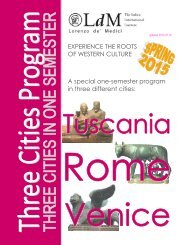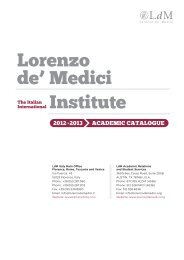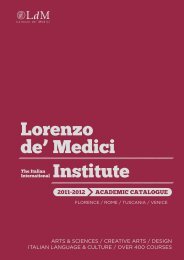aCademiC Catalog 2013-2014 - Lorenzo de Medici
aCademiC Catalog 2013-2014 - Lorenzo de Medici
aCademiC Catalog 2013-2014 - Lorenzo de Medici
Create successful ePaper yourself
Turn your PDF publications into a flip-book with our unique Google optimized e-Paper software.
FLORENCE<br />
School of Arts & Sciences<br />
War in the Ancient World<br />
CLA 246 F; Dual listed: HIS 246 F<br />
Cr: 3; Contact hrs: 45<br />
An exploration of warfare in ancient Greece and Rome in terms<br />
of values and i<strong>de</strong>ology, impact on society, practices, arms and<br />
artefacts, and representations. For Greece the focus is on the<br />
fifth-century through the Hellenistic era, while for Rome the<br />
entire time-span from monarchy through the empire and late<br />
Antiquity is consi<strong>de</strong>red. Stu<strong>de</strong>nts analyze the strategy and<br />
the unfolding of major wars and events, as well as the careers<br />
of outstanding figures including Alexan<strong>de</strong>r the Great and the<br />
emperor Augustus, promoter of the pax romana. Stu<strong>de</strong>nts<br />
come to grips with the mindset and actual experiences of<br />
comman<strong>de</strong>rs and common soldiers as they prepared for<br />
campaigns and engaged in battles and sieges. The civilian<br />
experience of war is not ignored. Space is <strong>de</strong>dicated to the<br />
problematic relationship between mo<strong>de</strong>rn regimes and ancient<br />
military culture, notably the Italian fascist excavations of<br />
imperial Roman sites for propagandistic ends.<br />
Archaeology of Religion: Death and Ritual in<br />
the Past<br />
CLA 252 F; Dual listed: PHR 252 F / ANT 252 F<br />
Cr: 3; Contact hrs: 45<br />
Religion is based on a combined system of beliefs and practices<br />
that allows people to answer fundamental questions regarding<br />
human life. What can archaeology tell us about religion? The<br />
course explores key questions regarding the role and evolution<br />
of religious beliefs and practices by systematically analyzing<br />
the archaeological remains of ancient religious material culture<br />
across the Mediterranean and the Ancient Near East, between<br />
the prehistoric and early classical periods. Direct links between<br />
religious practices and beliefs are strongly evi<strong>de</strong>nt in ancient<br />
societies, where the construction of large physical structures<br />
(such as temples) appears to be pivotal in the evolution<br />
of mankind. Stu<strong>de</strong>nts learn to use archaeological data and<br />
historical sources for the period. They address broad theoretical<br />
and methodological issues, explore how architecture was used<br />
by ancient societies in creating their cosmological landscape,<br />
and evaluate interpretations of the first appearance of family<br />
ancestor cults. The first part of the course treats theoretical<br />
and methodological issues in the study of religious thought,<br />
while the second part reinforces un<strong>de</strong>rstanding through close<br />
analysis of ancient written sources, architecture, and other<br />
examples of material culture.<br />
Prerequisites: one previous course in History of Religions,<br />
Cultural Anthropology, Archaeology<br />
Egyptian Art and Archaeology<br />
CLA 255 F<br />
Cr: 3; Contact hrs: 45<br />
The course provi<strong>de</strong>s an overview of ancient Egyptian<br />
civilization. It examines the material culture and human life of the<br />
inhabitants of the Nile Valley, and surveys major sites, objects,<br />
and texts to discover the essentials of Egyptian culture, politics,<br />
art, religion, and literature. The course covers 4000 years of<br />
ancient Egyptian civilization, from the origins of its culture<br />
in the late fourth millennium BCE to the late Roman Empire.<br />
This introduction to the art and archaeology of ancient Egypt<br />
also looks at the discipline of Egyptology, in which Italy has<br />
played an important part, and it will allow stu<strong>de</strong>nts to answer<br />
such questions as How did Ancient Egypt originate? How were<br />
the pyramids built? How do you read hieroglyphics? What<br />
did the afterlife signify for Egyptians? What was the Amarna<br />
revolution? The course will explain these and other topics using<br />
archaeological data and historical sources, starting from the<br />
pieces present in the notable Egyptian Museum of Florence.<br />
Ancient Tuscany: the Etruscan Civilization<br />
CLA 265 F; Dual listed: HIS 265 F<br />
Cr: 3; Contact hrs: 45<br />
This course offers an overview of the archaeological, historical<br />
and cultural features of the Etruscans, the ancient civilization<br />
that flowered in central Italy during the first millennium BCE.<br />
Stu<strong>de</strong>nts will explore this civilization, (known to itself as<br />
“Rasenna”), which contributed so much to Roman and later<br />
Italian culture and heritage, through in-class lectures and visits<br />
to selected, major museums and sites. Attention is given to both<br />
chronological periods and major issues (e.g. language, politics,<br />
art, burial customs), as well as essentials of archaeological<br />
practice. This course offers direct contact with the over 2500<br />
year-old archaeological finds in CAMNES/LdM’s Archaeology<br />
Lab. These finds have recently been unearthed at the digs of<br />
Accesa (Archaic period settlement) and at Bosco <strong>de</strong>lla Riserva<br />
and Pratino, near Tuscania, (Hellenistic necropolis), where two<br />
excavation projects have been conducted by CAMNES/LdM<br />
since 2005. The present course is an i<strong>de</strong>al preparation for the<br />
institute’s summer archaeological workshops.<br />
The Dawn of Humankind: Archaeology and<br />
Evolution<br />
CLA 292 F; Dual listed: ANT 292 F<br />
Cr: 3; Contact hrs: 45<br />
The course surveys topics and questions surrounding the<br />
fundamental events that characterize the human evolutionary<br />
path - a journey that continues still today. We will follow the<br />
appearance and disappearance of different hominid species<br />
that competed for resources, ultimately resulting in the survival<br />
of only one species - our own! How is evolution related to DNA?<br />
How did environmental conditions affect the evolutionary<br />
process? After hominids acquired an upright position (freeing<br />
our hands) and our brain expan<strong>de</strong>d (in relation to our body<br />
size), these traits eventually conditioned our material culture.<br />
When and where did the cultural explosion happen? We will<br />
seek answers through evi<strong>de</strong>nce such as new stone tools and the<br />
appearance of what we <strong>de</strong>fine today as symbolic expression.<br />
In<strong>de</strong>ed, the Paleolithic era, with its paintings, objects, and<br />
burials, takes us to the beginnings of human artistic expression<br />
and belief systems. This course will show how anthropologists<br />
and archaeologists find and retrieve evi<strong>de</strong>nce (fossil, artefact,<br />
site) from the past and then analyze it to learn how people in<br />
the past lived. In addition, it also explores explanations these<br />
fields offer for two profound questions: Who are we? Where do<br />
we come from?<br />
Ancient Near East: Roots of Western<br />
Civilization<br />
CLA 295 F<br />
Cr: 3; Contact hrs: 45<br />
The course explores the main features of ancient Near Eastern<br />
cultures, notably the Sumerians, Assyrians, and Hittites, between<br />
prehistory (ca. 10,000 BCE) and the <strong>de</strong>ath of Alexan<strong>de</strong>r the<br />
Great (323 BCE). We will focus on these cultures’ history,<br />
religion and socio-economic organization, mainly through their<br />
archaeological remains. The Near East was the cradle of the<br />
most ancient civilizations known to humanity. They <strong>de</strong>veloped in<br />
part of the so-called Middle East, corresponding to the “Fertile<br />
Crescent” region including those areas known as Mesopotamia,<br />
Anatolia, Syria, Palestine, and Persia. While the rest of the<br />
world was still organized in hunter-gatherer communities, in<br />
this area there appeared the first towns and cities ever built as<br />
well as the first writing system. In fact, the ancient Near Eastern<br />
civilizations were certainly the most influential of all antique<br />
cultures. To un<strong>de</strong>rstand them is to gain essential insights onto<br />
the origins of Western Civilization.<br />
The Age of the Heroes: Iliad, Odyssey, Aeneid,<br />
and the Origins of Western Literature<br />
CLA 306 F; Dual listed: LIT 306 F<br />
Cr: 3; Contact hrs: 45<br />
The course is a general overview of ancient literature through<br />
the analysis and comparison of some of the ol<strong>de</strong>st works of<br />
Western civilization. Through a reading of the most significant<br />
chapters of the Iliad and the Odyssey, stu<strong>de</strong>nts will get in<br />
contact with the aristocratic world and heroes <strong>de</strong>scribed by<br />
Homer in 8-7th century BCE, in or<strong>de</strong>r to reconstruct the society<br />
of early Greece in the Mycenaean period. The stories presented<br />
in the Iliad and Odyssey, consi<strong>de</strong>red the “Bible” of classical<br />
civilization, show how Greeks used myth to express archetypal<br />
values which became immortal for successive generations.<br />
Myths are analyzed not only as amazing stories but also as<br />
bearers of important messages about life within society, and<br />
as primary forms of communication and instruction in a nonliterate<br />
and oral society. The great influence of Greek myths on<br />
Roman legends will also be seen through the reading of some<br />
50<br />
LdM Aca<strong>de</strong>mic <strong>Catalog</strong> <strong>2013</strong>-<strong>2014</strong>





